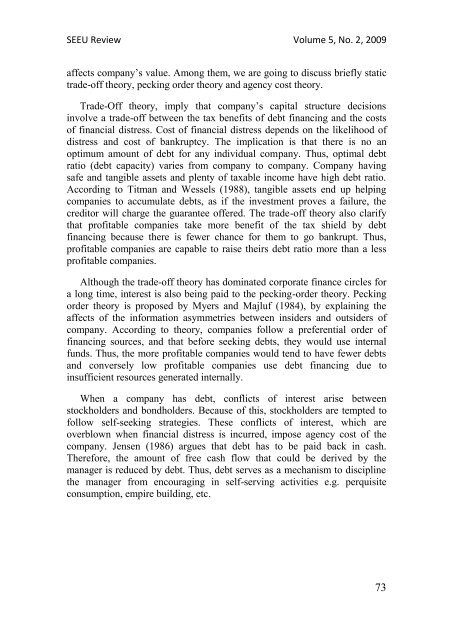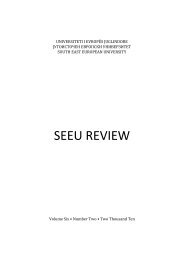SEEU Review vol. 5 Nr. 2 (pdf) - South East European University
SEEU Review vol. 5 Nr. 2 (pdf) - South East European University
SEEU Review vol. 5 Nr. 2 (pdf) - South East European University
Create successful ePaper yourself
Turn your PDF publications into a flip-book with our unique Google optimized e-Paper software.
<strong>SEEU</strong> <strong>Review</strong> Volume 5, No. 2, 2009<br />
affects company’s value. Among them, we are going to discuss briefly static<br />
trade-off theory, pecking order theory and agency cost theory.<br />
Trade-Off theory, imply that company’s capital structure decisions<br />
in<strong>vol</strong>ve a trade-off between the tax benefits of debt financing and the costs<br />
of financial distress. Cost of financial distress depends on the likelihood of<br />
distress and cost of bankruptcy. The implication is that there is no an<br />
optimum amount of debt for any individual company. Thus, optimal debt<br />
ratio (debt capacity) varies from company to company. Company having<br />
safe and tangible assets and plenty of taxable income have high debt ratio.<br />
According to Titman and Wessels (1988), tangible assets end up helping<br />
companies to accumulate debts, as if the investment proves a failure, the<br />
creditor will charge the guarantee offered. The trade-off theory also clarify<br />
that profitable companies take more benefit of the tax shield by debt<br />
financing because there is fewer chance for them to go bankrupt. Thus,<br />
profitable companies are capable to raise theirs debt ratio more than a less<br />
profitable companies.<br />
Although the trade-off theory has dominated corporate finance circles for<br />
a long time, interest is also being paid to the pecking-order theory. Pecking<br />
order theory is proposed by Myers and Majluf (1984), by explaining the<br />
affects of the information asymmetries between insiders and outsiders of<br />
company. According to theory, companies follow a preferential order of<br />
financing sources, and that before seeking debts, they would use internal<br />
funds. Thus, the more profitable companies would tend to have fewer debts<br />
and conversely low profitable companies use debt financing due to<br />
insufficient resources generated internally.<br />
When a company has debt, conflicts of interest arise between<br />
stockholders and bondholders. Because of this, stockholders are tempted to<br />
follow self-seeking strategies. These conflicts of interest, which are<br />
overblown when financial distress is incurred, impose agency cost of the<br />
company. Jensen (1986) argues that debt has to be paid back in cash.<br />
Therefore, the amount of free cash flow that could be derived by the<br />
manager is reduced by debt. Thus, debt serves as a mechanism to discipline<br />
the manager from encouraging in self-serving activities e.g. perquisite<br />
consumption, empire building, etc.<br />
73

















